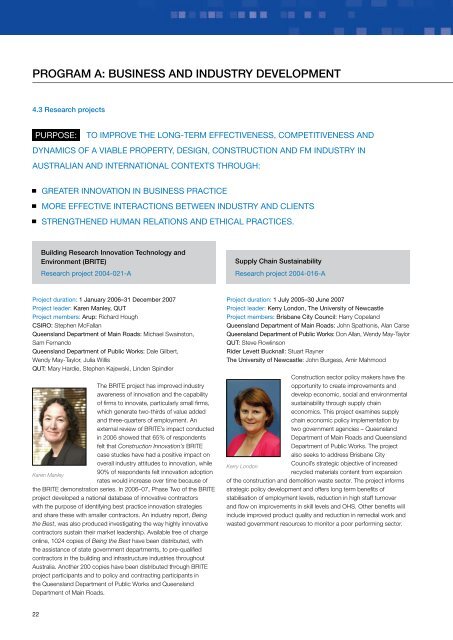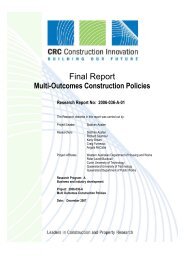2006-07 - Construction Innovation
2006-07 - Construction Innovation
2006-07 - Construction Innovation
You also want an ePaper? Increase the reach of your titles
YUMPU automatically turns print PDFs into web optimized ePapers that Google loves.
PROGRAM A: BUSINESS AND INDUSTRY DEVELOPMENT<br />
4.3 Research projects<br />
PURPOSE:<br />
TO IMPROVE THE LONG-TERM EFFECTIVENESS, COMPETITIVENESS AND<br />
DYNAMICS OF A VIABLE PROPERTY, DESIGN, CONSTRUCTION AND FM INDUSTRY IN<br />
AUSTRALIAN AND INTERNATIONAL CONTEXTS THROUGH:<br />
GREATER INNOVATION IN BUSINESS PRACTICE<br />
MORE EFFECTIVE INTERACTIONS BETWEEN INDUSTRY AND CLIENTS<br />
STRENGTHENED HUMAN RELATIONS AND ETHICAL PRACTICES.<br />
Building Research <strong>Innovation</strong> Technology and<br />
Environment (BRITE)<br />
Research project 2004-021-A<br />
Supply Chain Sustainability<br />
Research project 2004-016-A<br />
Project duration: 1 January <strong>2006</strong>–31 December 20<strong>07</strong><br />
Project leader: Karen Manley, QUT<br />
Project members: Arup: Richard Hough<br />
CSIRO: Stephen McFallan<br />
Queensland Department of Main Roads: Michael Swainston,<br />
Sam Fernando<br />
Queensland Department of Public Works: Dale Gilbert,<br />
Wendy May-Taylor, Julia Willis<br />
QUT: Mary Hardie, Stephen Kajewski, Linden Spindler<br />
The BRITE project has improved industry<br />
awareness of innovation and the capability<br />
of firms to innovate, particularly small firms,<br />
which generate two-thirds of value added<br />
and three-quarters of employment. An<br />
external review of BRITE’s impact conducted<br />
in <strong>2006</strong> showed that 65% of respondents<br />
felt that <strong>Construction</strong> <strong>Innovation</strong>’s BRITE<br />
case studies have had a positive impact on<br />
overall industry attitudes to innovation, while<br />
90% of respondents felt innovation adoption<br />
Karen Manley<br />
rates would increase over time because of<br />
the BRITE demonstration series. In <strong>2006</strong>–<strong>07</strong>, Phase Two of the BRITE<br />
project developed a national database of innovative contractors<br />
with the purpose of identifying best practice innovation strategies<br />
and share these with smaller contractors. An industry report, Being<br />
the Best, was also produced investigating the way highly innovative<br />
contractors sustain their market leadership. Available free of charge<br />
online, 1024 copies of Being the Best have been distributed, with<br />
the assistance of state government departments, to pre-qualified<br />
contractors in the building and infrastructure industries throughout<br />
Australia. Another 200 copies have been distributed through BRITE<br />
project participants and to policy and contracting participants in<br />
the Queensland Department of Public Works and Queensland<br />
Department of Main Roads.<br />
Project duration: 1 July 2005–30 June 20<strong>07</strong><br />
Project leader: Kerry London, The University of Newcastle<br />
Project members: Brisbane City Council: Harry Copeland<br />
Queensland Department of Main Roads: John Spathonis, Alan Carse<br />
Queensland Department of Public Works: Don Allan, Wendy May-Taylor<br />
QUT: Steve Rowlinson<br />
Rider Levett Bucknall: Stuart Rayner<br />
The University of Newcastle: John Burgess, Amir Mahmood<br />
<strong>Construction</strong> sector policy makers have the<br />
opportunity to create improvements and<br />
develop economic, social and environmental<br />
sustainability through supply chain<br />
economics. This project examines supply<br />
chain economic policy implementation by<br />
two government agencies – Queensland<br />
Department of Main Roads and Queensland<br />
Department of Public Works. The project<br />
also seeks to address Brisbane City<br />
Council’s strategic objective of increased<br />
Kerry London<br />
recycled materials content from expansion<br />
of the construction and demolition waste sector. The project informs<br />
strategic policy development and offers long term benefits of<br />
stabilisation of employment levels, reduction in high staff turnover<br />
and flow on improvements in skill levels and OHS. Other benefits will<br />
include improved product quality and reduction in remedial work and<br />
wasted government resources to monitor a poor performing sector.<br />
22

















